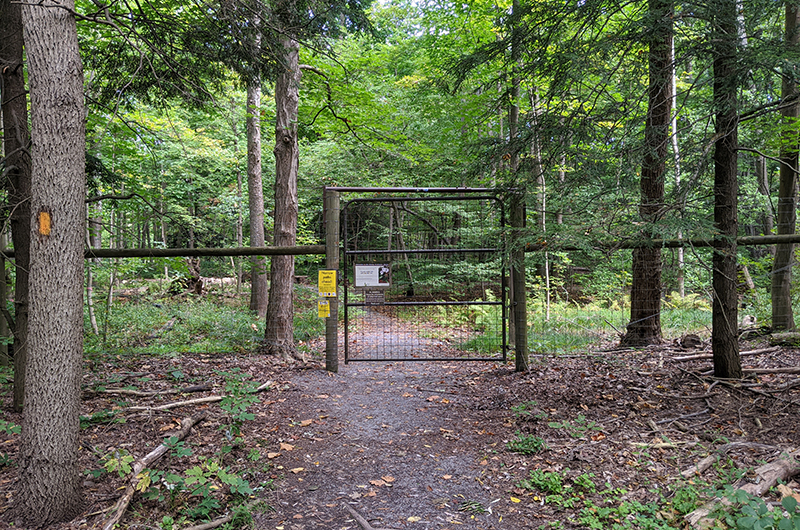![]()
Deer Management
Sustainable Landscapes Trail at Cornell University
The fence at this location was constructed in 2015 around this diverse plant community rich in early spring wildflowers to protect it from deer—a big challenge to conserving this garden’s plant diversity. Read more below about how and why deer is managed at Cornell.

Deer fence in the Mundy Wildflower Garden.
Why is this site sustainable?
Deer population management is essential to maintaining or restoring ecosystem health in our region’s natural areas and suburban landscapes. With the increase of local deer populations, Cornell’s natural lands have experienced changes in forest structure, decreases in native plant populations and reproduction, and increases in invasive plants. Since our native plant and wildlife abundance and diversity are tightly linked, losses ripple up the food chain, negatively impacting many other mammals as well as insects, reptiles, amphibians, and birds.
Cornell Botanic Gardens plays a large role in developing, implementing, and studying various aspects of lethal and non-lethal deer management approaches across its 3400 acres of natural areas holdings, aimed at providing a safe, healthy, and flourishing environment.
Deer Research & Management

In the northeast, natural deer predators like cougars and wolves have been extirpated, leaving humans, deer-vehicle collisions, disease, and food supply limitations as the main means for population control. Deer hunting in urban/suburban areas is challenging, so populations typically go unmanaged and quickly outstrip local resources.
Chronic deer overpopulation leads to:
- The degradation of plant biodiversity, which compromises the health of natural ecosystems.
- A potential increase in risk of contracting Lyme disease: A suburban Connecticut study found that reducing deer density (from 39.8 to 54.5 deer per km2 to 0 to 9.8 deer per square km2) resulted in a 76% reduction in tick abundance and an 80% reduction in resident-reported cases of Lyme disease in the community from before to after the deer management program was initiated (Kilpatrick, et al., 2014).
- An increase in deer-vehicle collisions: A 2012 report in Outdoor News cited over 80,000 deer-vehicle collisions in New York over a one-year period, which was the third highest rate per U.S. state.
Beginning in 2008, Cornell launched the Integrated Deer Research and Management Program (IDRM), which aimed to reduce deer damage to lands, collections, research plots, and natural areas (i.e., “outdoor classrooms”) by 75% while also reducing risk to staff, students and visitors of Lyme disease and deer-vehicle collisions.
Early implementation included:
- A surgical doe sterilization program on core campus
- A consolidated hunting program that experimented with incentives to increase doe harvest (earn-a-buck, deer management assistance permits, and establishment of a pilot New York State Deer Management Focus Area, which liberalized antlerless harvest regulations in and around Ithaca)
- Subsequently over 800 deer have been harvested
- Learn more about this program.
Deer Management Construction
Fencing ornamental and research plantings in high-value natural areas: Here at the Mundy Wildflower Garden, an 8-foot fence was built around 8 of the area’s 15 acres in 2008. Since it was installed, staff and student interns have collected data on the forest plant cover inside and outside of the fence to compare the impact of deer browse on ecosystem health and biodiversity. Using herbaceous wildflowers that deer prefer as indicators, data are collected on individual species; red trillium (Trillium erectum), white trillium (Trillium grandiflorum), false Solomon’s-seal (Maianthemum racemosum), and hairy Solomon’s-seal (Polygonatum pubescens), among others. You may notice flags marking the plots. Height, flowering, fruiting, and browse are recorded to evaluate deer impact. Overall, the heights of the plants inside the exclosures were more evenly distributed over all possible heights, whereas plants outside the exclosure had more stems of shorter heights. Also plants were more fertile, flowering and fruiting more freely, inside the exclosure than those outside.
This is an ongoing project. As data are collected and compiled each year, we get a clearer understanding of the impact of deer on these plant populations and a better picture of the intensity and timing of our deer browse problems.
To measure deer population density and impact, progress on accomplishments are also assessed annually using bait stations, game cameras, and mark-recapture data as well as changes to ecological health indicators such as oak seedling browse and survival. A report summarizing program efforts through 2012 titled “An Integrated Approach for Managing White-tailed Deer in Suburban Environments” can be found here. Initial IDRM program goals were not met, and Cornell’s Deer Management Committee recommended use of State-issued Deer Depredation Permits using trained volunteer bow hunters. Beginning with a trial period in 2013, this approach has been expanded and appeared successful in reducing the campus deer population by 50% in 2015. Each year we collect data to determine the deer population to evaluate the success of our deer management effort. These efforts are on-going. (show chart on deer population from 2009-2016)
